There are three basic types of suspension components: linkages, springs, and shock absorbers. The linkages are the bars and brackets that support the wheels, springs, and shock absorbers. Springs cushion the vehicle by dampening shock loads from bumps and holes in the road. Shock absorbers use hydraulic pistons and cylinders to cushion also the vehicle from shock loads. They also serve to dampen spring oscillations, thus bring the vehicle back to a neutral position soon after being shock-loaded by a road obstruction.
Link
There are a number of various-shaped links that are used for the different types of suspension systems.  They vary from straight bars to forged, cast, or stamped metal shapes that best fit to support the springs, shocks, and wheels onto vehicle frames or body structures. The simplest linkage is a straight bar that connects one wheel to the other on the opposite side of the vehicle. Others can be intricately shaped to connect springs, shock absorbers, and wheels to vehicles as explained later.
They vary from straight bars to forged, cast, or stamped metal shapes that best fit to support the springs, shocks, and wheels onto vehicle frames or body structures. The simplest linkage is a straight bar that connects one wheel to the other on the opposite side of the vehicle. Others can be intricately shaped to connect springs, shock absorbers, and wheels to vehicles as explained later.
Springs
There are three different spring types that are used in suspension systems: coil, leaf, and torsion bar. Coil springs are merely wound torsion bars. 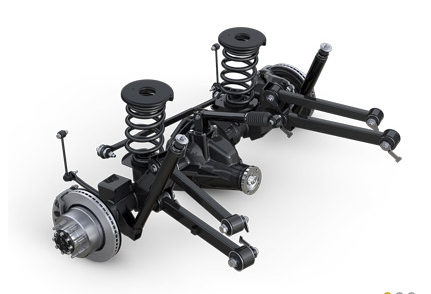 They are commonly used because they are compact, easily mounted, and have excellent endurance life properties. Leaf springs are long thin members that are loaded in bending. They are used as an assembly being comprised of several layers of thin metal to obtain the correct spring rate. Leaf springs serve as both the damping member and the linkage. Torsion bars rely on the twist of a long bar to provide a spring rate to dampen car shock loading. Torsion bars mount across the bottom portion of a vehicle and are more difficult to package than others.
They are commonly used because they are compact, easily mounted, and have excellent endurance life properties. Leaf springs are long thin members that are loaded in bending. They are used as an assembly being comprised of several layers of thin metal to obtain the correct spring rate. Leaf springs serve as both the damping member and the linkage. Torsion bars rely on the twist of a long bar to provide a spring rate to dampen car shock loading. Torsion bars mount across the bottom portion of a vehicle and are more difficult to package than others.
Shock Absorbers
Use a piston and cylinder along with adjustable valves to control the flow of hydraulic fluid to set the damping force in both the retract (jounce) and extend (rebound) positions. 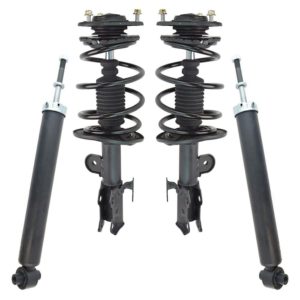 Shock absorbers are set to retract under a lower force than to extend. This action absorbs road bump forces and dampens spring oscillations resulting in better vehicle ride and control.
Shock absorbers are set to retract under a lower force than to extend. This action absorbs road bump forces and dampens spring oscillations resulting in better vehicle ride and control.
Suspension System Terms
-
Camber: Looking directly at the front of the vehicle, camber refers to the tilt in (+) or out (‐) of the bottom half of the tire.
-
Caster: Looking directly at the side of the vehicle, caster refers to the tilt rearward (+) of the bottom half of the tire.
- Toe: Looking directly at the top of the vehicle, toe refers to the slant in (+) or out (‐) of the front half of the tire.
- Jounce: Jounce refers to the bounce or vertical movement of the vehicle suspension upward when it contacts a bump in the road.
- Rebound: Rebound refers to the movement of the vehicle suspension in the opposite direction of jounce.
- Shimmy: Shimmy is an uncontrollable oscillation of the steering system experienced by two opposing wheels.
- Knuckle: The knuckle is the suspension component that incorporates the spindle or hub that the wheel bearings and wheels mount on.
- King Pin: The kingpin is the vertical component in the knuckle that the wheels turn on when the vehicle is steered.
- Spindle: The spindle is the long tapered bar‐shaped piece that is fitted to the knuckle on which the wheel bearings and wheels are mounted.
- Hub: The hub is the hollow part of the knuckle that replaces the spindle in mounting the bearings that support the wheel.
- Ball Joint: A ball joint is a fastener or connector that allows movement in all directions.
- Tie Rod: A tie rod is a component that firmly connects one wheel of a vehicle to the wheel on the opposite end to provide steering.
- Track Bar: A track bar is a rod that connects a suspension beam to the frame to give lateral support.
- Unsprung Weight: Unsprung weight is the total weight of all components in a vehicle that are not dampened by the springs and shocks like the wheels and other closely associated equipment.
- Scrub: Scrub is the lateral movement of a tire against the pavement due to suspension system camber changes during jounce and rebound.

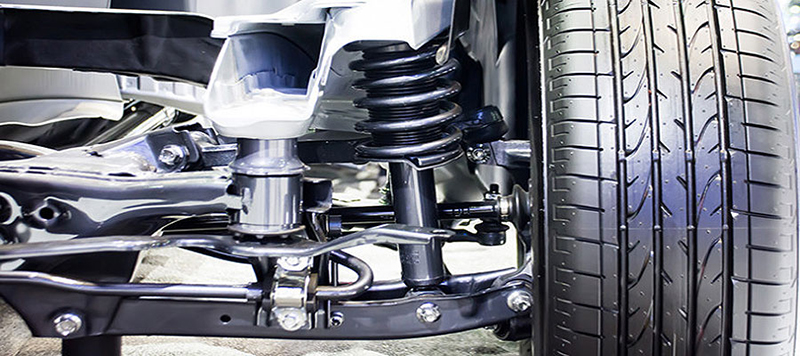

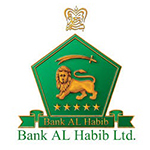
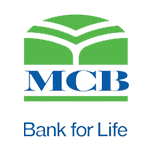







[…] the 1990s, cooling system components shifted to more aluminum and nylon, so coolant was reformulated to protect these new materials. This type of coolant uses […]
[…] pump which activates to even out the vehicle’s weight distribution automatically. This helps to ensure a smooth ride, even when you’re carrying unusual loads. Unsurprisingly, these shocks don’t come […]
[…] we have already mentioned above, independent suspension systems are the preferred set up by many of today’s manufacturers. Such a setup allows each wheel […]
[…] car has certain cranking power requirements to get it started. You can find these numbers in the owner’s […]